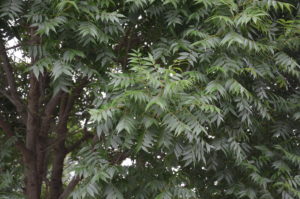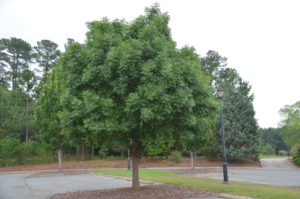Chinese pistache tree (Pistachia chinensis) is an underplanted small 30-35 foot landscape tree native to China, Taiwan and the Philippines (USDA hardiness zones 6b-9). It is related to the edible nut pistache tree (Pistachia vera).
Foliage consists of pinnate compound, dark green leaves (to 10 inches long), each leaf typically having 10-12 lanceolate leaflets (to 4 inches long). The tree displays a fine leaf texture. The small leaflets are an easy clean-up at raking time. Foliage is aromatic when bruised. The eye catching fall color is crimson red, bright orange, or occasionally yellow.
This tree species is dioecious, e.g a single tree is either male or female. Pistache blooms in April but is not a standout compared to all shrubs and trees flowering at this time. Female flower clusters are nearly twice as wide as males. The non-edible fruits turn red in summer before ripening to blue-purple in winter. However, the berries (drupes, ¼ inches in diameter) are a food source for birds. Gray-brown bark on older trees peels to reveal salmon inner bark.
Chinese pistache grows in moist, compost rich, well-drained soils in full sun. It prospers in full sun but can handle partial shade. Verticillium wilt can become a serious problem in poorly drained soil. A 2-year old established tree tolerates summer heat, drought, and moderate air pollution. Annual pruning in early years is essential to maintain a symmetrical tree with good form.
If you are concerned about berries dropping on walkways, select a fruitless male clone, P. chinensis ‘Keith Davey,’ a 35-foot high tree with a crown diameter of 30 feet.



 Posted in
Posted in 
